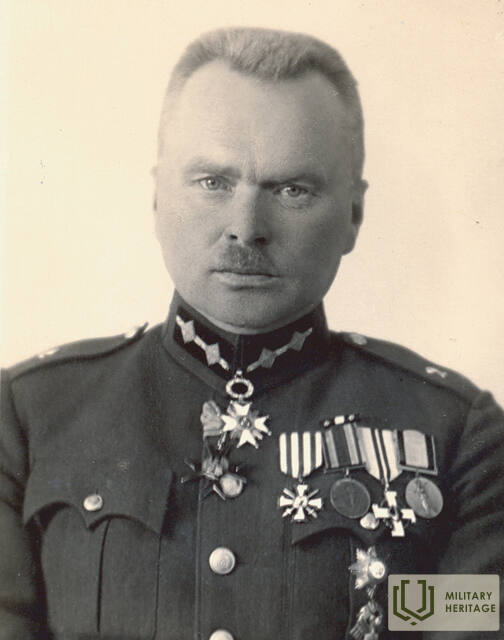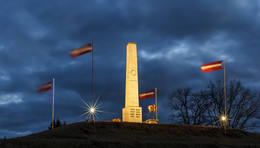Мемориальный момент на Гарнизонном кладбище
После восстановления независимости Латвии Улдис Велдре, руководитель отдела Комитета братских кладбищ Алуксне, позаботился о содержании Гарнизонного кладбища, выявлении связанных с ЛКОК мест отдыха, связанных с Алуксне, и установке мемориалов. на Гарнизонном кладбище.
«Когда я узнал, что В. Спандегс (1890-1941) умер, я уже отмечал его 100-летний юбилей на Алуксненском гарнизонном кладбище у Большого Белого Креста во время советской оккупации 19 декабря 1990 года, открыв ему белый Лачплесис мрамор. плита. На этой мемориальной доске всегда живые цветы, она тщательно убрана, особо отметим даты рождения и смерти генерала В. Спандега - 19 декабря, 16 октября и День Лачплесиса - 11 ноября. Это было также 16 октября, когда мы отметили 60-летие со дня смерти Лачплесиса Вилиса Спандегса. В почетном карауле с латвийским флагом и знаменем батальона стояли храбрые стражи Отечества - бойцы Алуксненского мобильного стрелкового батальона (МБС), знаменосцы Алуксненской государственной гимназии Э. Глики. В 1938 году полковник Вилис Спандегс подарил Алуксненской государственной гимназии флаг - подарок 7-го Сигулдского пехотного полка. В завершение Часа любви к Отечеству представители нашего национального героя - семьи Лачплесис Виня Спандега, Алуксненский братский кладбищенский комитет, Алуксненский МСБ, Лачплесис Эдуардс.
Внук Кокле Сандрис, внук Альбертс и внук Адель Ливини посадили дуб, чтобы вечно жила светлая память о последнем командире 7-го Сигулдского пехотного полка, рыцаре Ордена гробниц Лачплесиса, тогдашнем полковнике Вине Спандеге. Вместе с ребятами из MSB мы привезли Озолиню с земли великого латыша Зигфрида Калача. Выбор был не случаен. Ранней весной 1919 года в боях под Резакой, Яунлайцене, Апе вторым батальоном Валмиерского полка командовал житель нашего уезда (Гауяен) Карлис Боярс - рыцарь III степени Лачплесского военного ордена, командующий 7-й Сигулдской пехотой. Полк Герои не умирают. Они будут жить в самом сердце нашей нации, даже когда не будет детей моего поколения - Алуксне и подлинной истории Латвии более 60 лет назад. Пусть никогда не будет недостатка в героях, которые могут и готовы отдать все, что у них есть, за свою Родину, за свою страну и за нацию ».
Ролик посвящен памяти Вилюса Спандеги.
Улдис Велдре, председатель комитета кладбища братьев Алуксне. В Алуксне упоминается Вили Спандега. Речь идет о Лачплесисе. Свободная Латвия: Джойнт «Лондонская газета» и «Латвия», 10 ноября 2001 г., вып. 43.
https://www.youtube.com/watch?v=jtzCjhm80so
Связанная хронология
Связанные объекты
Алуксненское гарнизонное кладбище
Расположен на берегу озера Алуксне, на полуострове Капсета, на территории Большого кладбища.
Они были заложены и содержались солдатами 7-го Сигулдского пехотного полка в 1930-х годах и освящены 11 ноября 1932 года. После восстановления независимости Латвии Улдис Велдре, глава отдела Комитета Алуксненского кладбища, позаботился о содержании Гарнизонного кладбища, выявлении связанных с Алуксне мест захоронения и установке мемориалов в Гарнизоне. Кладбище.
На гарнизонном кладбище похоронены военнослужащие Армии Латвийской Республики, а также солдаты и мирные жители, погибшие в боях с большевиками 4 июля 1941 года в Алуксне под Янкалниньшем и 7 июля 1941 года в Зиемерской волости.
Большинство погребенных имеют белые деревянные кресты с металлическими табличками, на которых указано имя усопшего, чин или род занятий, а также даты рождения и смерти.
19 декабря 1990 года на Гарнизонном кладбище был открыт памятник Вилюсу Шпандегу, кавалеру Военного ордена Лачплесиса. Также были установлены стандартные мемориальные доски ЛКОК, которые погибли или были убиты в коммунистических концлагерях и не были похоронены в Латвии. 11 ноября 1990 года был установлен памятник Вольдемарсу Закису, погибшему в коммунистическом концентрационном лагере.
Памятник воинам 7-го Сигулдского пехотного полка, погибшим в Освободительной войне Латвии.
Расположен на берегу озера Алуксне, на краю улицы Плескавас (Kolberg Road).
22 июня 1923 года президент Латвии Янис Чаксте открыл памятник павшим солдатам 7-го Сигулдского пехотного полка. Памятник создан по проекту художника Юлия Мисниекса.
Солдаты полка также благоустроили и привели в порядок территорию вокруг памятника. Солдаты собирались у памятника в канун годового праздника полка, когда был зажжен святой огонь, а также в день годовщины полка после парада и заступничества на гарнизонном кладбище.
1940/1941 Большевики сняли и уничтожили мемориальную доску в 1953 г., но сам памятник был снесен в 1953 г., а его камни заложены в фундаменте угла казарменного дома.
В начале Пробуждения, осенью 1989 года, была проведена уборка территории вокруг разрушенного памятника, который еще находился на территории оккупационных войск СССР. 11 ноября на прежнем месте памятника был открыт временный гранитный мемориал с надписью: «11 ноября 1989 года на этом месте будет восстановлен памятник 7-му Сигулдскому пехотному полку».
По инициативе председателя Комитета Алуксненского кладбища У. Велдре была начата реставрация памятника, и 16 октября 2009 г. восстановленный памятник был открыт.
В отличие от оригинального памятника, на полке обелиска вместо нагрудного знака был создан крест. Обе скульптуры памятника были выполнены скульптором Айнарсом Зельцсом. Для восстановленного памятника использовалась как часть 22 оригинальных блоков-обелисков, найденных на территории пехотного училища Национальных вооруженных сил, так и вновь построенные блоки.
20 июня 2019 года в рамках празднования столетия Сигулдского пехотного полка у подножия холма-памятника были открыты мемориал и гранитная мемориальная доска погибшим воинам части. Мемориальный комплекс построен на средства, пожертвованные личным составом пехотной школы Национальных вооруженных сил.







